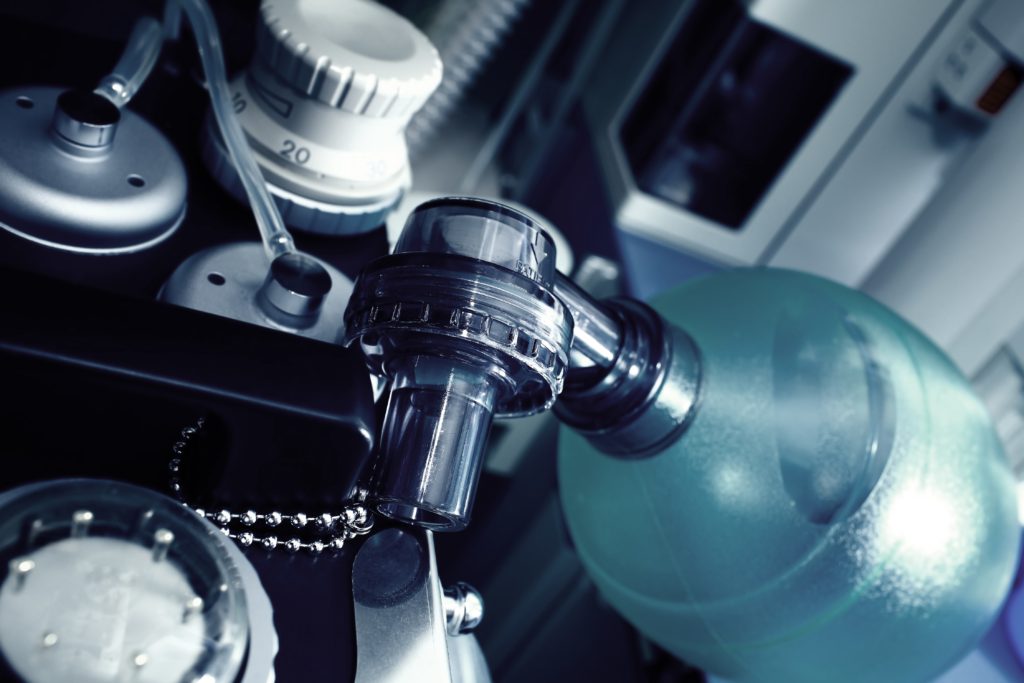General anesthesia is administered either through intravenous or inhalation methods.1 Anesthesiologists give inhalation anesthesia, which has been common for over 80 years,2 through a laryngeal mask airway, anesthesia mask or tracheal tube connected to an anesthetic vaporizer and an anesthetic delivery system.3 Given the ubiquity of inhalation anesthesia, its global market has become a common topic of study.3-6
The global inhalation anesthesia market was valued at $1.12 billion in 2018.6 The market can be segmented by product type, application type, region, end user and key players.3,5 By product, inhalation anesthesia is split into sevoflurane, isoflurane and desflurane.5 In 2018, sevoflurane dominated the global market in terms of revenue, valued at $768.6 million.5 By application type, inhalation anesthesia is segmented into induction, which is putting a patient under anesthesia, and maintenance, which is keeping a patient properly anesthetized throughout a procedure.7 Inhaled anesthetics are usually preferred over other types for maintenance of anesthesia, as they allow for precise, low-cost control of a patient’s anesthetic state.7 The geographic regions represented in the inhalation anesthesia market are North America, Europe, Asia Pacific, Latin America and the Middle East and Africa (MEA).5 In 2018, North America held the largest share of the market at $456.0 million.5 Other countries with competitive market shares included Argentina, Brazil, France, Germany, Italy, Spain and the United Kingdom.4 Meanwhile, the market in the MEA region was small, likely because countries in this region are low income, lack advanced medical facilities and have limited numbers of health professionals and low healthcare investment.4 By end user, the market can be segmented into groups such as hospitals, ambulatory surgical centers and more.3 Key market players include Halocarbon Products Corporation, Baxter, Hikima Pharmaceuticals, Lunan Pharmaceutical Group, Piramal Enterprises Limited, Jiangsu Hengrui Medicine, Fresenius Kabi and AbbVie.5
The inhalation anesthesia market is expected to grow at a compound annual growth rate (CAGR) of 3.8 percent until 2025.4,6 The two main drivers for market growth are inhalation anesthesia’s precision of maintenance during procedures,4,7 as well as an increasing geriatric population who suffer from chronic ailments and degenerative diseases.4 The latter contributes to a rise in the number of surgical procedures and a higher prevalence of cardiovascular and respiratory illnesses.4 Universal health insurance coverage and improvements in healthcare infrastructure may also cause market growth in some regions.5 Meanwhile, growing concern about the role of greenhouse gases such as sevoflurane, isoflurane and desflurane in climate change may hinder market growth.8 Nevertheless, sevoflurane’s market share is expected to grow due to its therapeutic advantages, low cost and high potency.5 Isoflurane will see an even higher growth rate than sevoflurane, with a CAGR of 6.3 percent until 2025, thanks to its reduced effects on cardiovascular function and thus increased use in anesthesia maintenance for weak or geriatric patients.5 Though the North American market will see significant growth over the forecast period, Asia Pacific is predicted to have the highest CAGR at 4.0 percent, due to an increasing population and number of patients suffering from chronic disease.5
Overall, the inhalation anesthesia market can be segmented into various product types, applications, end users and regions, with some product types and regions showing clear success over others. Over the next six years, isoflurane and Asia Pacific are expected to see increases in market shares. A rise in chronic diseases and improved healthcare policy in some countries is likely to contribute to growth in the global inhalation anesthesia market.
1. Visser K, M.D., Hassink Elly A, Ph.D., Bonsel Gouke J, M.D., Ph.D., Moen J, R.N., Kalkman Cor J, M.D., Ph.D. Randomized Controlled Trial of Total Intravenous Anesthesia with Propofol versus Inhalation Anesthesia with Isoflurane–Nitrous Oxide: Postoperative Nausea and Vomiting and Economic Analysis. Anesthesiology: The Journal of the American Society of Anesthesiologists. 2001;95(3):616–626.
2. Guedel AE. Inhalation Anesthesia: A Fundamental Guide. Anesthesia & Analgesia. 1937;16(2):119–120.
3. Inhalation Anesthetics Market: Industry Analysis Outlook By Size, Share, Growth, Trends And Forecast 2016–2022 [press release]. Web: MarketWatch August 28, 2019.
4. Market Research Future. Inhalation Anesthesia Market 2019 | Global Size, Share, Comprehensive Research Study, Regional Trends, Business Growth, Competitive Landscape, Emerging Opportunities and Forecast to 2025. August 30, 2019.
5. Grand View Research. Inhalation Anesthesia Market Worth $1.42 Billion By 2025 | CAGR: 3.5%. San Francisco, CA April 2019.
6. Anand A. Inhalation Anesthesia Market Held A Valuation of USD 1.12 Billion in 2018 With 3.8% CAGR By 2025, Says Analyst at MRFR. August 12, 2019.
7. Eger EI, 2nd. Characteristics of anesthetic agents used for induction and maintenance of general anesthesia. American Journal of Health-System Pharmacy. 2004;61 Suppl 4:S3–10.
8. Yasny JS, White J. Environmental implications of anesthetic gases. Anesthesia progress. 2012;59(4):154–158.
